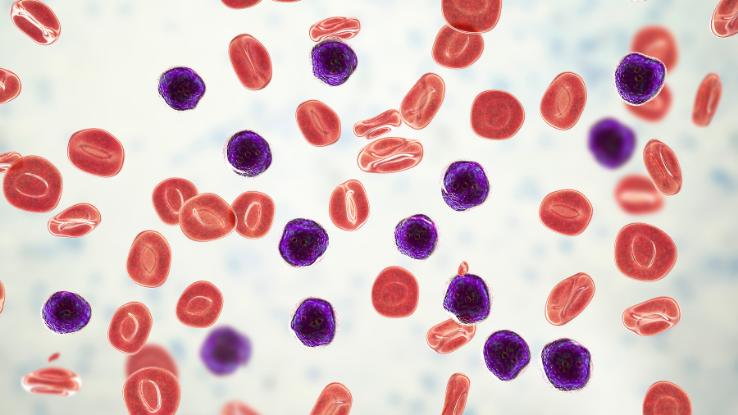How to Power Passive Speakers Without an Amp

Leukemia is a form of cancer that affects blood-forming tissues and/or cells — primarily those of the lymphatic system and bone marrow. This cancer most often impacts white blood cells, but it can also develop in other types of blood cells as well. Moreover, it's different from most other cancers because the cancerous cells circulate throughout the bloodstream, as opposed to forming a mass or tumor.
Leukemia occurs when the bone marrow produces an excessive amount of abnormal white blood cells (leukemia cells) that do not function properly. These continually replicating leukemia cells start to crowd normal white and red blood cells along with platelets and prevent these normal cells from carrying out their regular functions, thus wreaking havoc on the body.
Are There Different Types of Leukemia?
Leukemia is actually a blanket term that can refer to a spectrum of related cancers. The different types of leukemia can be broken down into two different groups, which are determined by how fast the disease develops:
- Chronic Leukemia: This type of leukemia progresses slowly and is more common in adults. Symptoms may not be present in early stages because the leukemia cells are still able to at least partially function in the capacity of normal white blood cells. However, as the amount of leukemia cells slowly begins to increase, the signs and symptoms of leukemia begin to appear.
- Acute Leukemia: This type of leukemia progresses quickly and is the most common cancer in children. The leukemia cells rapidly divide and cannot function like normal white blood cells. Because the leukemia cells crowd out normal, functioning cells at such a fast pace, symptoms can grow progressively worse, very quickly.
Different types of leukemia are also classified by the particular type of cell that is affected. The four most common types are:
- Chronic lymphocytic leukemia (CLL): This cancer originates from lymphoid cells, which normally develop into white blood cells. It typically affects older adults (over 65 years of age) and accounts for approximately one-third of all leukemia cases.
- Chronic myeloid leukemia (CML): This leukemia originates from myeloid cells, which normally develop into red or white blood cells or platelets. It also mainly affects older adults but only accounts for approximately 10% of all leukemia cases.
- Acute lymphocytic leukemia (ALL): This cancer originates from lymphoid cells, but it spreads quickly. It is the most common leukemia in children, adolescents, and young adults (under 39 years of age).
- Acute myeloid leukemia (AML): This leukemia originates from myeloid cells and spreads quickly. It occurs in children and adults but is most common in older adults.
Although they are rarer, other types of leukemia include hairy cell leukemia, myelodysplastic syndromes, and myeloproliferative disorders.
Symptoms Associated With Leukemia
Chronic leukemia may be asymptomatic for a long period of time because the disease progresses slowly, meaning it's commonly diagnosed during routine check-ups or while checking for other health issues. Usually, the first sign of chronic leukemia is an enlarged lymph node. Although symptoms for leukemia vary based the type of leukemia, common symptoms include:
- Fever
- Fatigue
- Paleness
- Frequent or recurrent infections
- Unexplained weight loss
- Swollen lymph nodes
- Enlarged liver or spleen
- Easy bleeding and/or bruising
- Appearance of tiny red spots on the skin (petechiae)
- Night sweats
- Bone or joint pain
- Shortness of breath
- Pain or pressure on the left side under the ribs
Causes & Risk Factors
Generally, leukemia results from genetic mutations that cause abnormal and accelerated cell division, but the exact causes of these mutations remains unclear. Still, leukemia abnormalities appear to stem from both genetic and environmental factors, including:
- Smoking
- Chemical exposure (e.g. benzene, formaldehyde)
- Genetic disorders (e.g. Down's Syndrome, Klinefelter Syndrome, neurofibromatosis, Schwachman-Diamond Syndrome)
- Previous cancer treatments (e.g. radiation, chemotherapy)
- Family history of leukemia
Note: Anyone can develop leukemia at any age whether these risk factors are present or not.
Diagnosis
A complete blood count (CBC) test is the first level of diagnostic testing for leukemia. For this test, experts will analyze the amount of white blood cells, red blood cells, and platelets in a blood sample; a sample with a high level of white blood cells and low level of red blood cells can indicate leukemia. If this is the case, other blood samples may be taken and examined at a higher level to form a more accurate diagnosis. Additional tests may examine blood cells for the presence of any chromosomal or genetic abnormalities — or for the presence of certain leukemia-associated surface proteins.
If leukemia is a possibility, a bone marrow biopsy may be ordered. During this procedure, a long needle is inserted into the bone — usually the pelvic bone — to obtain a bone marrow sample. The sample is then analyzed to determine the presence of any abnormal cells.
Other tests may include a lumbar puncture (spinal tap), where the doctor uses a needle to take a sample of spinal fluid so that it can be examined for leukemia cells; and imaging tests, including X-rays, MRI scans, and CT scans, all of which visually examine the bones and organs to check for cancer-related abnormalities.
Treatment
Leukemia treatment plans are individualized to the needs of the patient and the extent of the disease. Important factors include the patient's age, general health, family medical history, and past cancer diagnoses. Common treatment options include:
- Chemotherapy: This therapy involves the use of common drugs to kill the leukemia cells.
- Targeted Therapy: These treatments target specific molecules or genes in the leukemia cells to eliminate them.
- Radiation: This treatment uses high-energy beams to kill the leukemia cells.
- Bone Marrow Transplantation: This treatment is also referred to as a stem cell transplantation. It involves replacing the patient's unhealthy bone marrow cells with non-cancerous stem cells that will produce healthy bone marrow.
- Immunotherapy: These therapies use the patient's immune system to identify and destroy the leukemia cells.
- Clinical trials: These are experimental treatments or therapies that may have uncertain benefits and risks. Clinical trials are often recommended when conventional treatment methods fail.
In most situations, therapy involves a combination of chemotherapy and radiation, especially with acute leukemia patients who need an aggressive course of treatment as soon as possible. In many cases, bone marrow transplants are relatively successful. And, even though leukemia can be a deadly condition, many patients are able to fight the disease and receive a positive prognosis for a long and healthy life.

Next Steps for Folks Who Receive a Diagnosis
A cancer diagnosis can be life altering. But, fortunately, many individuals survive leukemia and achieve long-term remission. Therefore, it is important to learn to cope with the disease. Need some help navigating your diagnosis or the diagnosis of a friend or family member? Try the following:
- Educate yourself about leukemia and the available treatment options.
- Strengthen your close relationships to ensure both practical and emotional support.
- Talk with someone about your leukemia. Cancer support groups are available, and information can be found through the National Cancer Institute or the American Cancer Society.
Resource Links:
- "Leukemia" via American Cancer Society
- "Leukemia" via Mayo Clinic
- "Leukemia" via Cleveland Clinic
- "Leukemia" via MD Anderson Cancer Center, The University of Texas
MORE FROM SYMPTOMFIND.COM
How to Power Passive Speakers Without an Amp
Source: https://www.symptomfind.com/health/condition-leukemia-cancer?utm_content=params%3Ao%3D740013%26ad%3DdirN%26qo%3DserpIndex